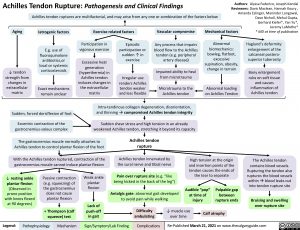Achilles Tendon Rupture: Pathogenesis and Clinical Findings
Achilles tendon ruptures are multifactorial, and may arise from any one or combination of the factors below
Authors: Alyssa Federico, Joseph Kendal Reviewers: Davis Maclean, Hannah Koury , Amanda Eslinger, Maninder Longowal, Dave Nicholl, Mehul Gupta, Gerhard Kiefer*, Yan Yu*, Jeremy LaMothe* * MD at time of publication
Aging
Iatrogenic factors
E.g. use of fluoroquinolone antibiotics,or local or systemic corticosteroids
Exact mechanisms remain unclear
Exercise related factors
Vascular compromise
Any process that impairs blood flow to the Achilles tendon (e.g. peripheral artery disease)
Impaired ability to heal from microtrauma
Mechanical factors
Abnormal biomechanics:
bowleg, flatfoot, excessive supination, obesity, change in terrain
Participation in vigorous exercise
Excessive heat generation
(hyperthermia) in Achilles tendon induces changes in the extracellular matrix
Intra-tendinous collagen degeneration, disorientation, and thinningàcompromised Achilles tendon integrity
Sudden shear stress and high tension in an already weakened Achilles tendon, stretching it beyond its capacity
Haglund’s deformity: enlargement of the calcaneal postero- superior tuberosity
Bony enlargement rubs on soft tissue and causes inflammation of Achilles tendon
↓ tendon strength from
changes in extracellular matrix
Episodic participation or sudden ↑ in exercise
Irregular use renders Achilles tendon weaker
Microtrauma to the
and less flexible Achilles tendon on Achilles Tendon
Abnormal loading
Sudden, forced dorsiflexion of foot
Eccentric contraction of the gastrocnemius-soleus complex
The gastrocnemius muscle normally attaches to Achilles tendon to control plantar flexion of the foot
With the Achilles tendon ruptured, contraction of the gastrocnemius muscle cannot induce plantar flexion
Achilles tendon rupture
Achilles tendon innervated by the sural nerve and tibial nerve
Pain over rupture site (e.g. “like being kicked in the back of the leg”)
Antalgic gate: abnormal gait developed to avoid pain while walking
High tension at the origin and insertion points of the tendon causes the ends of the tear to separate
The Achilles tendon contains blood vessels. Rupturing the tendon also ruptures the blood vessels withinàblood leaks out into tendon rupture site
Bruising and swelling over rupture site
↓ resting ankle plantar flexion (Observed in prone position with knees flexed at 90 degrees)
Passive contraction (e.g. squeezing) of the gastrocnemius does not cause plantar flexion
+ Thompson (calf squeeze) test
Weak ankle plantar flexion
Lack of push-off in gait
Audible “pop” at time of injury
Palpable gap between rupture ends
Difficulty ambulating
↓ muscle use over time
Calf atrophy
Legend:
Pathophysiology
Mechanism
Sign/Symptom/Lab Finding
Complications
Re-Published March 21, 2021 on www.thecalgaryguide.com

